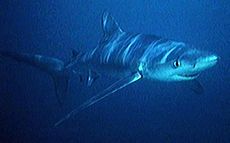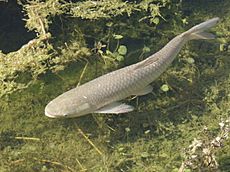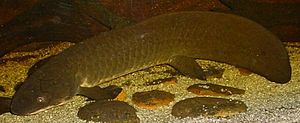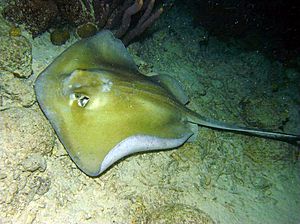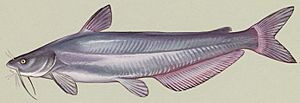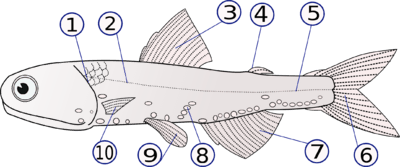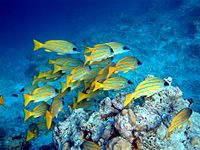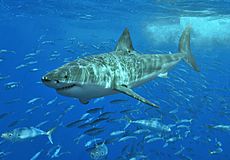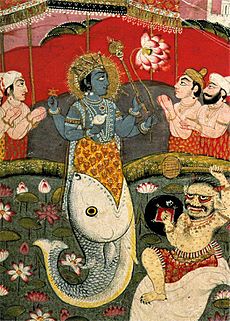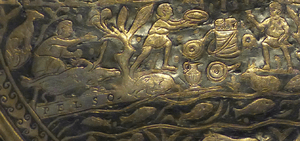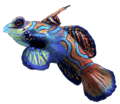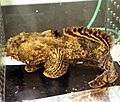Fish facts for kids
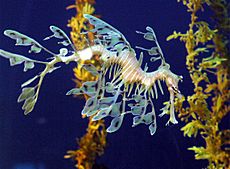
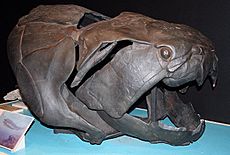
Fish (plural: fish or fishes) are vertebrates which live in water and respire (get oxygen) with gills. They lack limbs with digits (fingers & toes). This is a definition which does not quite work: some amphibia also live in water and have external gills, but they are not fishes.
Fish used to be a class of vertebrates. Now the term covers five classes of aquatic vertebrates:
There are more fish than tetrapods (land vertebrates): there are over 33,000 described species of fish. Fish are usually covered with scales. They have two sets of paired fins and several unpaired fins. Most fish are cold-blooded (poikilotherm). A fish takes in the oxygen from the water using gills. There are many different kinds of fish. They live in fresh water in lakes and rivers, and in salt water in the ocean. Some fish are less than one centimeter long. The largest fish is the whale shark, which can be almost 15 meters long and weigh 15 tons. Most fish live in the water. A group of fish called the lungfish have developed lungs because they live in rivers and pools which dry up in certain parts of the year. They burrow into mud and aestivate until the water returns.
'Fish' is a paraphyletic term in cladistics because it lacks a monophyletic group of descendants. It does not include the land vertebrates or tetrapods, which descended from fish.
Contents
Fish or fishes?
Though often used interchangeably, these words have different meanings. Fish is used either as singular noun or to describe a group of specimens from a single species. Fishes describes a group of different species.
Types of fish
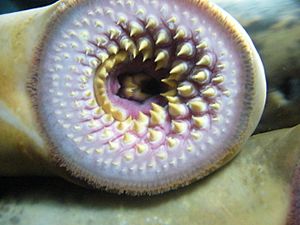
Fish, the oldest vertebrate group, includes a huge range of types, from the Middle Ordovician, about 490 million years ago, to the present day. These are the main groups:
- Agnatha: the jawless fish. Cambrian to present day.
- Pteraspids: the head-shields
- Anaspids: gills opened as holes. Silurian to end-Devonian.
- Cephalaspids: early jawless fish
- Lampreys: living ectoparasites
- Osteostraci: bony-armoured jawless fish.
- Gnathostomata: the jawed fish. Includes all types commonly called fish, except the lamprey.
- Placoderms: heavily armoured fish
- Chondrichthyes: cartilaginous fish: sharks, rays and skates.
- Acanthodii: extinct spiny sharks
- Osteichthyes: bony fish.
- Actinopterygii: the ray-finned fish.
- Chondrostei: sturgeons and some other early types.
- Neopterygii: first seen in the later Permian, lighter and faster-moving than previous groups.
- Sarcopterygii: the lobe-finned fish
- Dipnoi: the lungfish; eight genera survive.
- Coelacanths: two species survive. They were probably a sister-group to the tetrapods.
- Actinopterygii: the ray-finned fish.
Certain animals that have the word fish in their name are not really fish: Crayfish are crustaceans, and jellyfish are Cnidarians. Some animals look like fish, but are not. Whales and dolphins are mammals, for example.
Anatomy
Bony and cartilagenous fish
Most kinds of fish have bones. Some kinds of fish, such as sharks and rays, do not have real bones (their skeletons are made of cartilage) they are known as cartilaginous fish.
Gills
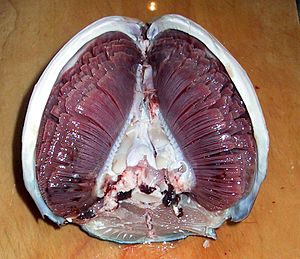
Most fish exchange gases using gills on either side of the pharynx. Gills consist of threadlike structures called filaments. Each filament contains a capillary network that provides a large surface area for exchanging oxygen and carbon dioxide. Fish exchange gases by pulling oxygen-rich water through their mouths and pumping it over their gills. In some fish, capillary blood flows in the opposite direction to the water, causing countercurrent exchange. The gills push the oxygen-poor water out through openings in the sides of the pharynx. Some fish, like sharks and lampreys, possess multiple gill openings. However, bony fish have a single gill opening on each side. This opening is hidden beneath a protective bony cover called an operculum.
Juvenile bichirs have external gills, a very primitive feature that they share with larval amphibians.
Fish scales
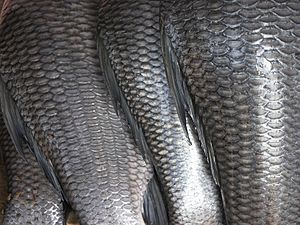
All fish are covered with overlapping scales, and each major group of fish has its own special type of scale. Teleosts ('modern' fish) have what are called leptoid scales. These grow in concentric circles and overlap in a head to tail direction like roof tiles. Sharks and other chondrichthyes have placoid scales made of denticles, like small versions of their teeth. These also overlap in a head to tail direction, producing a tough outer layer. Shark skin is available for purchase as shagreen, a leather which as original is smooth in one direction, and rough in the other direction. It may be polished for use, but is always rough in texture and resistant to slipping.
The scales are usually covered with a layer of slime which improves passage through the water, and makes the fish more slippery to a predator.
Swimming
Fish swim by exerting force against the surrounding water. There are exceptions, but this is usually done by the fish contracting muscles on either side of its body in order to generate waves of flexion that travel the length of the body from nose to tail, generally getting larger as they go along. Most fishes generate thrust using lateral movements of their body & tail fin (caudal fin). However, there are also species which move mainly using their median and paired fins. The latter group profits from the gained manoeuvrability that is needed when living in coral reefs for example. But they can not swim as fast as fish using their bodies & caudal fins.
Muscle
Fish can swim slowly for many hours using red muscle fibres. They also make short, fast bursts using white muscle. The two types of muscle have a fundamentally different physiology. The red fibres are usually alongside a much greater number of white fibres.
Swimming in groups
Many fish swim in groups. Schools of fish can swim together for long distances, and may be chased by predators which also swim in schools. Casual groups are called 'shoals'.
Body shape
The shape of the body of a fish is important to its swimming. This is because streamlined body shapes makes the water drag less. Here are some common fish shapes.
Streamlining
The picture on the right shows a shark. This shark's shape is called fusiform, and it is an ovoid shape where both ends of the fish are pointy. This is the best shape for going through water quickly. Fishes with fusiform shapes can chase prey and escape predators quickly. Many live in the open ocean and swim constantly, like marlins, swordfish, and tuna. Ichthyosaurs, porpoises, dolphins, killer whales all have similar shapes. This is an example of convergent evolution.
Eel-like
The long, ribbon-like shape of an eel's body shows another shape. This enables them to hide in cracks, springing out quickly to capture prey, then returning quickly to their hiding spot.
Flatfish
Flatfish live on the bottom of the ocean or lake. Most use camouflage: they change colors to match the ocean floor.
Compressed
Fish with compressed shapes have flat, vertical bodies, with one eye on each side. They swim upright and can be very thin. They usually live in reefs where their flat bodies can slip in and out among the corals, sponges, and rocks, keeping hidden from predators. Angelfish, surgeonfish, and butterflyfish are all compressed fish.
Importance to humans
Economic importance

Throughout history, humans have utilized fish as a food source. Historically and today, most fish protein has come by means of catching wild fish. However, aquaculture, or fish farming, which has been practiced since about 3,500 BCE. in China, is becoming increasingly important in many nations. Overall, about one-sixth of the world's protein is estimated to be provided by fish. That proportion is considerably elevated in some developing nations and regions heavily dependent on the sea. In a similar manner, fish have been tied to trade.
Catching fish for the purpose of food or sport is known as fishing, while the organized effort by humans to catch fish is called a fishery. Fisheries are a huge global business and provide income for millions of people. The annual yield from all fisheries worldwide is about 154 million tons, with popular species including herring, cod, anchovy, tuna, flounder, and salmon. However, the term fishery is broadly applied, and includes more organisms than just fish, such as mollusks and crustaceans, which are often called "fish" when used as food.
Recreation
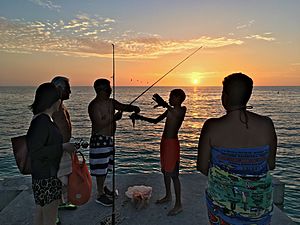
Fish have been recognized as a source of beauty for almost as long as used for food, appearing in cave art, being raised as ornamental fish in ponds, and displayed in aquariums in homes, offices, or public settings.
Recreational fishing is fishing for pleasure or competition; it can be contrasted with commercial fishing, which is fishing for profit. The most common form of recreational fishing is done with a rod, reel, line, hooks and any one of a wide range of baits. Angling is a method of fishing, specifically the practice of catching fish by means of an "angle" (hook). Anglers must select the right hook, cast accurately, and retrieve at the right speed while considering water and weather conditions, species, fish response, time of the day, and other factors.
Culture
Fish feature prominently in art and literature, in movies such as Finding Nemo and books such as The Old Man and the Sea. Large fish, particularly sharks, have frequently been the subject of horror movies and thrillers, most notably the novel Jaws, which spawned a series of films of the same name that in turn inspired similar films or parodies such as Shark Tale and Snakehead Terror. Piranhas are shown in a similar light to sharks in films such as Piranha; however, contrary to popular belief, the red-bellied piranha is actually a generally timid scavenger species that is unlikely to harm humans. In the Book of Jonah a "great fish" swallowed Jonah the Prophet. Legends of half-human, half-fish mermaids have featured in folklore, including the stories of Hans Christian Andersen.
Fish themes have symbolic significance in many religions. The fish is used often as a symbol by Christians to represent Jesus, or Christianity in general; the gospels also refer to "fishers of men" and feeding the multitude. In the dhamma of Buddhism the fish symbolize happiness as they have complete freedom of movement in the water. Often drawn in the form of carp which are regarded in the Orient as sacred on account of their elegant beauty, size and life-span. Among the deities said to take the form of a fish are Ika-Roa of the Polynesians, Dagon of various ancient Semitic peoples, the shark-gods of Hawaiʻi and Matsya of the Hindus.
The astrological symbol Pisces is based on a constellation of the same name, but there is also a second fish constellation in the night sky, Piscis Austrinus.
Fish as pets
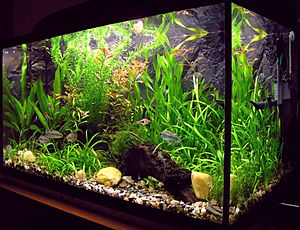
Some people keep fish as pets. Goldfish and Siamese Fighting Fish are popular types of pet fish. Koi and other ornamental fish are often kept by groups of people in public ponds for their beauty and calming nature.
| Vertebrates |
|---|
| Amphibian • Bird • Fish • Mammal • Reptile |
Images for kids
-
Lower jaw of the placoderm Eastmanosteus pustulosus, showing the shearing structures ("teeth") on its oral surface; from the Devonian of Wisconsin
-
Leedsichthys, of the subclass Actinopterygii, is the largest known fish, with estimates in 2005 putting its maximum size at 16 metres (52 ft).
-
The psychedelic mandarin dragonet is one of only two animal species known to have blue colouring because of cellular pigment.
-
Diversity of various groups of fish (and other vertebrates) through time
-
The bowfin Amia calva is the sole survivor of the halecomorph clade.
-
Didactic model of a fish heart
-
Dorsal view of the brain of the rainbow trout
-
Whale sharks, the largest species of fish, are classified as vulnerable.
-
Fish counter display at the Oulu Market Hall in Oulu, Finland.
-
Actinopterygii (Brown trout)
-
Sarcopterygii (Coelacanth)
-
Egg of lamprey
-
Egg of chimaera
See also
 In Spanish: Pez para niños
In Spanish: Pez para niños


